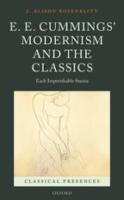
OUP (2016) h/b 370pp £60.00 (ISBN 9780198767152)
This book provides a compendious treatment of the relationship between the poetry of the American poet E.E. Cummings [the press’s capitalised preference. Ed.] and classical literature, complete with excellent appendices that include previously unpublished material translations and essays. The main focus of R.’s study is how Cummings used receptions of classical literature to reflect on his sexuality, his experience of war and his place in the poetic tradition, and how Cummings developed this approach through his experience as a Classics major at Harvard in the 1910s.
R.’s engaging readings of Cummings’ poetry are very strong; particularly commendable is R.’s habit of citing the poetry of Cummings (and others, including H. D.) at length, giving an excellent flavour of the poet to the uninitiated. The ten chapters cover topics including Cummings’ approach to classical translation, his fascination with satyrs and the primitive elements of the ancient world and his response to the First World War, and they all demonstrate a broad knowledge of Cummings and a real passion for his poetry.
I have only a couple of comments for the would-be reader (whom I urge to read this book regardless). The chapters do not follow a chronological order, and one result of this is that the details of Cumming’s life are often only briefly glimpsed, such as when we learn on one of the final pages that Cummings traced his lack of desire to write long poems, and thus become a ‘major’ poet, to the breakdown of his first marriage and his estrangement from his only daughter (pp. 243-4). Another element of the work that is regularly invoked but does not always feel fully developed is a discussion of Cummings’ debt to Freud, who looms large in the book not only as an influence on Cummings but also as a crucial source for its general concerns (including the opposition of sexuality and aggression and the anxiety of influence). In the same way it would have been helpful to have a chapter dedicated to the exciting literary connections between Cummings and the leading lights of the modernist movement, including Eliot, Pound and Joyce, as well as with Milton and Dante.
But these alternative paths are acknowledged in the ‘Afterword’ as being outside the author’s scope, and do not detract from R.’s overall achievement: this is a rich trove of analyses and details about the connections between Cummings and the classics that will engage and excite readers interested in the poet and his world.
Adam Lecznar
